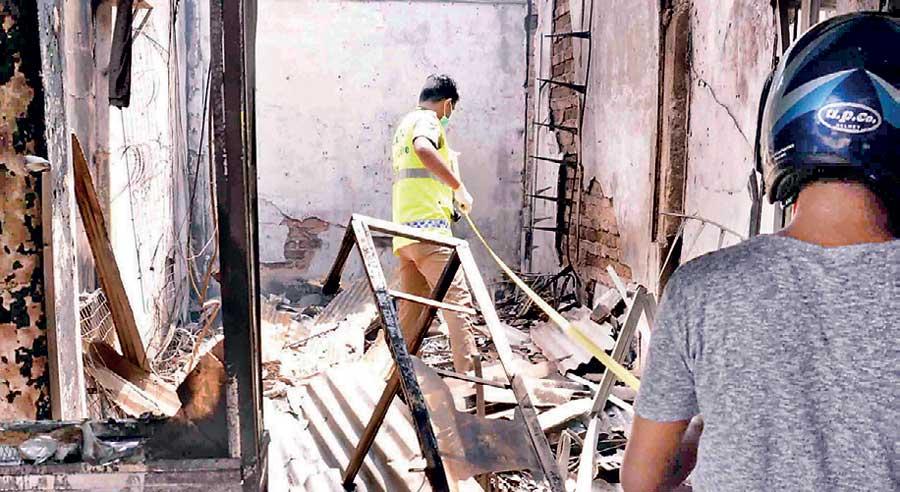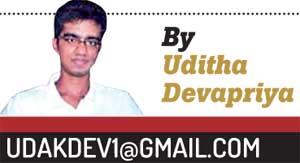Reply To:
Name - Reply Comment

Though not an avowed Buddhist, I’ve come to understand that the words of the Buddha, the Buddha Vachana, have in them a profound meaning which gets lost and obscured in the fog of ideology. Put simply, they are more adhered to in the letter than the spirit. Not that this hasn’t happened or doesn’t happen with other faiths, of course: how many of those who make claims about “pure Buddhism” can make as compelling claims about pure Christianity, pure Hinduism, pure Islam, and so on? The truth is that there’s nothing pure about any religion that gets appropriated by people.
What happened last Sunday and Monday, in that sense, had nothing to do with religion and at the same time had everything to do with religion. Those who claimed that the Easter attacks were linked to the faith adhered to by the suicide bombers can only be dismissed as hypocrites if they don’t apply the same logic to the motorbike mob (among whom, as one video showed, was a monk) who went on a rampage and tried to reawaken the memories of 1983. Most of these bikers were young. They did not fall from the sky. They had an identity. Sinhala and Buddhist.
The implications of the counter attacks – who organised them, whether the attackers were really of and from the villages in which they happened, whether the politicians and their supporters seen at police stations aided and abetted them the way that certain politicians aided and abetted the chauvinists who went on a rampage in 1983, whether the army stood there while the fires brought Muslim businesses and houses down – are being discussed. 
Prior to the counter-carnage (a “radical Sinhala Buddhist attack” if we are to be more specific), there was a distinct, though non-racist, hardening of attitude towards what was felt to be the complicity of certain radical and even non-radical elements within the Muslim community. If this doesn’t surprise you, consider that even at the height of the war, the last 15 years of which I was a witness to, there was no similar hardening of attitudes
among the milieu.
Even a cursory glance at the kind of responses given by the Muslim community, and the counter-reactions of those outside it, would indicate a completely different picture to what we saw in the last two decades of the Civil War. To compare the one with the other would be a case of comparing apples and oranges, but then this had nothing to do with the nature of the terrorists, what faith they adhered to, and what cause they were fighting for only; these would anyway have distinguished Easter 2019 from, say, Central Bank 1996. Rather, the growing animus against Muslims had to do with what was perceived to be a lack of response from them towards the radicalisation of their community. Of course, to be fair, non-Muslims were as much to blame for the resultant confusions here as were Muslims.
Regarding the former, there was, for instance, an extrapolation made from the attacks to the niqab. As Dayan Jayatilleka has pointed out, Muslim women resorted to the veil during the Algerian War to smuggle in guns and bombs. There is also a Tintin comic in which the hero and his sidekick Haddock try to exit enemy territory wearing (of all things) niqabs, only to be unveiled by a Muslim woman. But the Algerian War lasted from 1954 to 1962 and The Red Sea Sharkswas written by Hergé at the height of that war in 1958. Today the veil has taken on new meanings, to do with the autonomy of the woman and her place in a Muslim society. That is why it is unforgivable that non-Muslims should conclude that a niqab wearer is automatically a terrorist.
Regarding the latter, barring several moderates from the community there was a general apathy, if not unwillingness, to discuss certain tabooed subjects. Why were swords found in Mosques? To this the reply was, reasonably, that of the more than 1,800-plus Mosques in the country only three had yielded these weapons. What about the Halal controversy, i.e. what purposes were incomes earned from the certification being channelled to? To that the reply was, again reasonably, that they were used for the welfare of the community. Except that those questions were being asked at a time when more than 250 people had been slaughtered in broad daylight by radicalised elements from one community. The context was different. To give just one example, the Halal controversy arose for the first time in 2014, when Aluthgama was attacked. Though the involvement of the government in the attacks has not been verified, the year was significant for Sinhala Buddhist chauvinists since it evoked memories of 1915, the equivalent for Muslims of “1983”. The Halal controversy could hence be brushed aside as having contributed to mass scale, arbitrary, heinous attacks on an ethnic minority.
 Easter Sunday 2019 was not Aluthgama 2014 or for that matter Digana 2018. So when people, particularly those hailing from affected communities, speak up and question as to why Halal is enforced and to what ends the money earned from it in restaurants and groceries is channelled, the response should be more than the perfunctory “Well, it’s a custom of ours.” Attempts at stopping the debate at that point don’t augur or bode well for either the victimised or the radicalised community. On their part, what non-Muslims need to understand is that one cannot simply and magically expect the Muslim community to adhere to a way of living in a State which has been as alien to them as it is to us (Sinhala Buddhists). Same goes for the wearing of the niqab: while claims about the ban being irrelevant and a knee-jerk reaction are neither accurate nor fair, it is something ingrained in their culture which goes beyond the secular ideal of one law for one State. That is why one needs to offer empathy, not hate, towards those who refuse to stick to the ban.
Easter Sunday 2019 was not Aluthgama 2014 or for that matter Digana 2018. So when people, particularly those hailing from affected communities, speak up and question as to why Halal is enforced and to what ends the money earned from it in restaurants and groceries is channelled, the response should be more than the perfunctory “Well, it’s a custom of ours.” Attempts at stopping the debate at that point don’t augur or bode well for either the victimised or the radicalised community. On their part, what non-Muslims need to understand is that one cannot simply and magically expect the Muslim community to adhere to a way of living in a State which has been as alien to them as it is to us (Sinhala Buddhists). Same goes for the wearing of the niqab: while claims about the ban being irrelevant and a knee-jerk reaction are neither accurate nor fair, it is something ingrained in their culture which goes beyond the secular ideal of one law for one State. That is why one needs to offer empathy, not hate, towards those who refuse to stick to the ban.
In an article written to the New York Review of Books in 2016 (“How the French Face Terror”), Mark Lilla argues that prior to the immigration of Asians and Muslims to the continent, European society rationalised the divide between the Church and State in terms of individual rights – a legacy of Locke and Rousseau. For example, a person arrested for indulging in his religion to the detriment of another wasn’t penalised for professing his faith, but rather for having infringed on the civil rights of the other. The problem with this approach was that it was applicable to groups that could be
treated as individuals.
But that this means the community from which a set of terrorists emerged can play the victim card (to borrow an overused term) in the face of heightened security checks and standardisation of laws would be futile and counterproductive. If Buddhists and Christians were vocal about racist radical monks and unethical evangelisation, then it is only rational to expect similar sentiments against radical Islamic outfits, practices, and ministers from Muslims, without defensive tactics one usually sees when being attacked. Introspection, means looking in. Not making excuses.
The debate over this will continue, however. I cannot stop it, and nor can you. If celebration of a multicultural identity means standardisation of laws, then I’m all for it. Even Muslim commentators, some of whom are going back to the “Muslim identity needs to be protected” bandwagon hypocritically now, championed a standardisation along those lines. And yet, we know this is not going to be easy to stick to.
A fatal rift exists between multiculturalism – rooted in post-enlightenment European thinking – and the multiculturalism THEY and even WE (Buddhists) have come to expect. It’s not going to be easy to resolve this conflict, but until we do, this country is going to remain a society of one law for all which ends up concealing the richness of diversity.At times of crisis there’s nothing else that we can do apart from conforming to what has been enforced. So what shall we do? Conform. Accordingly. The law,
after all, is supreme.